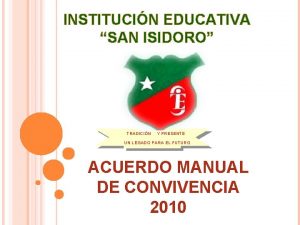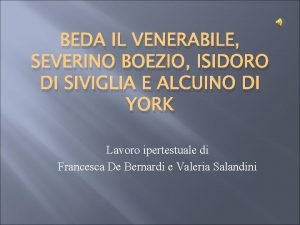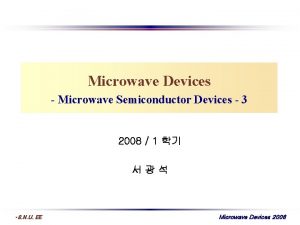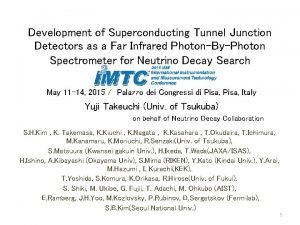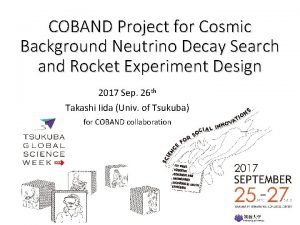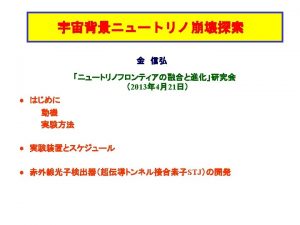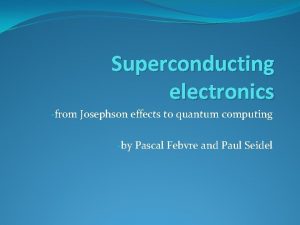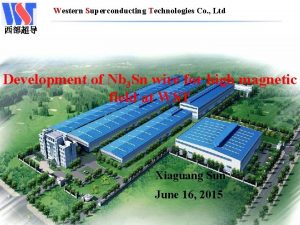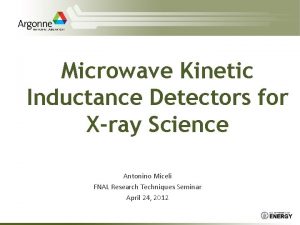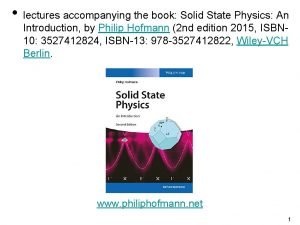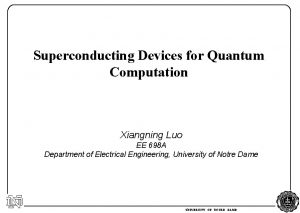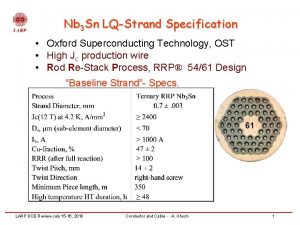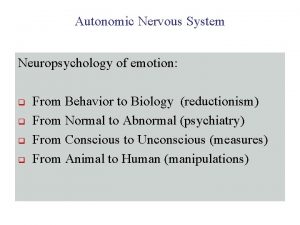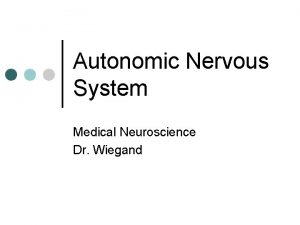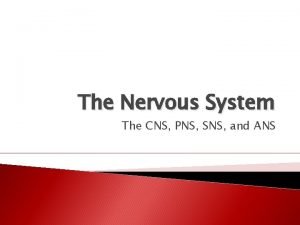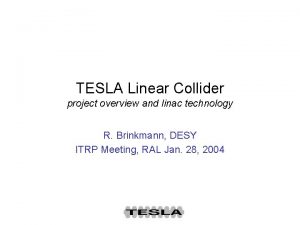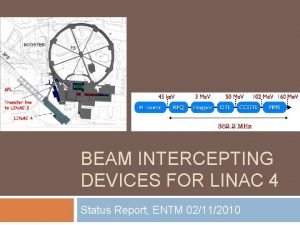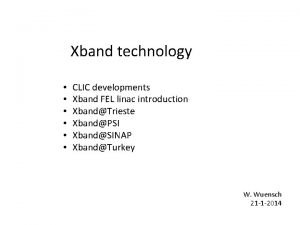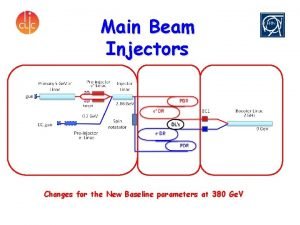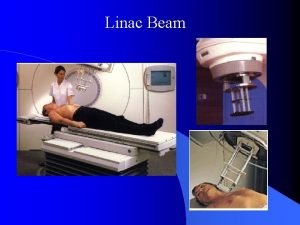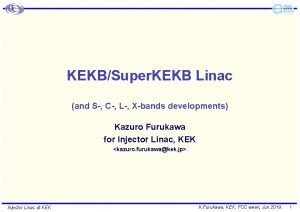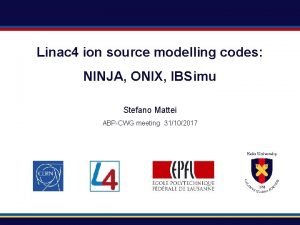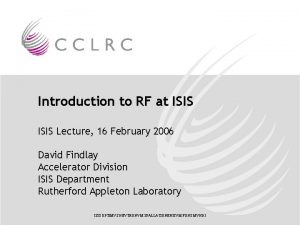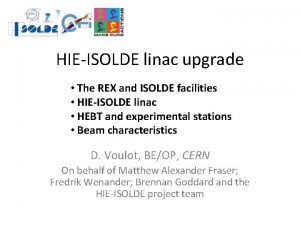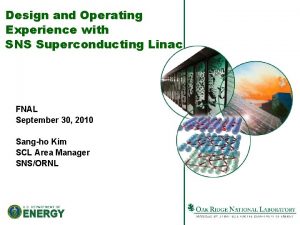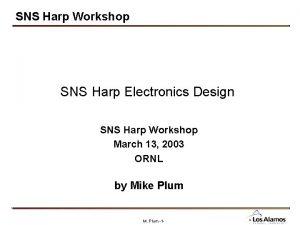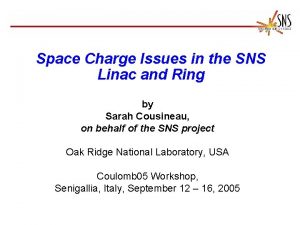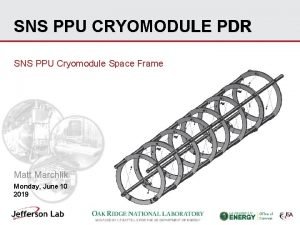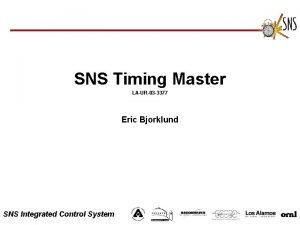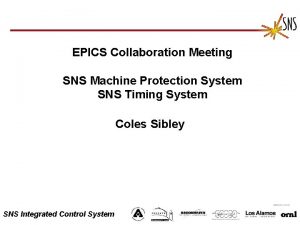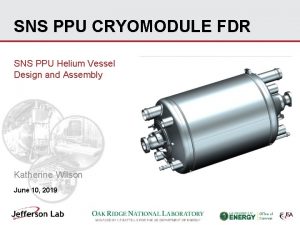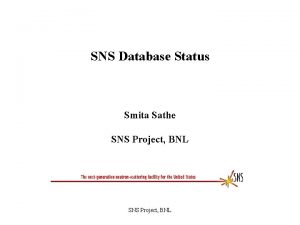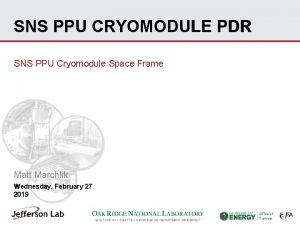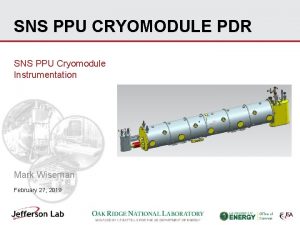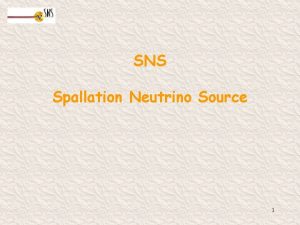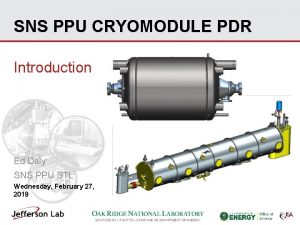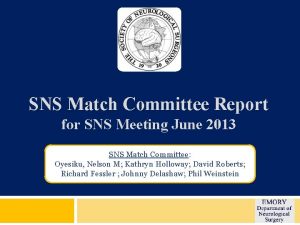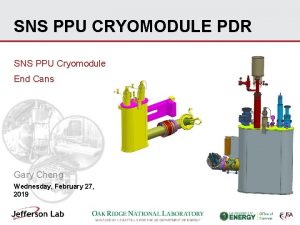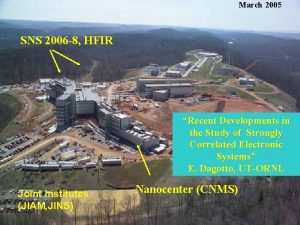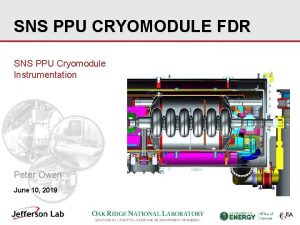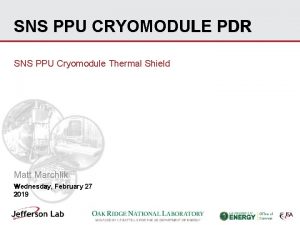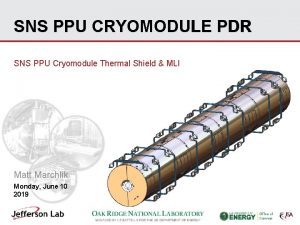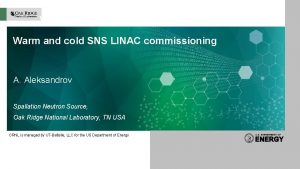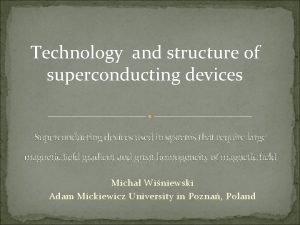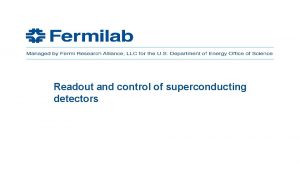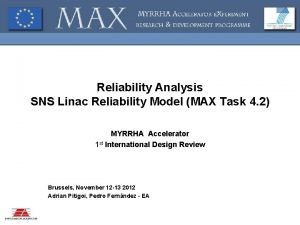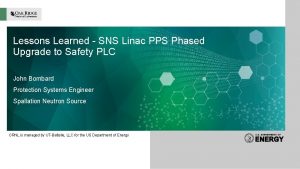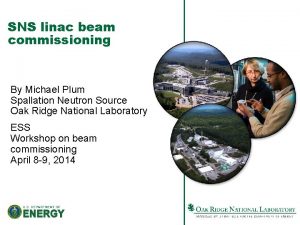SNS Superconducting Linac operating experience and issues Isidoro



























- Slides: 27

SNS Superconducting Linac operating experience and issues Isidoro E. Campisi and Sang-Ho Kim For the SNS Team Accelerator Physics and Technology Workshop for Project X November 12 -13, 2007

SNS Accelerator • Pulsed Superconducting RF: operated at 805 MHz, 1. 3 ms, 1. 0 ms flat top, 60 Hz, 7. 8% RF duty cycle • SNS cavities and cryomodules designed and built at JLab Accelerator Physics and Technology Workshop for Project X November 12 -13, 2007 OAK RIDGE NATIONAL LABORATORY U. S. DEPARTMENT OF ENERGY 2

Superconducting Linac · SCL accelerates beam from 186 to 1000 Me. V (nominal) - Reached 1011 Me. V - Run at 850 -890 Me. V most of the time - Presently run at 845 Me. V (1 cavity as spare, 1 HBCM missing) · 81 Niobium cavities in 23 cryomodules (33 medium. 61 beta, 48 high. 81 beta) · Until Spring 2007 mostly run at 4. 5 K (can run up to 30 Hz, 1. 3 msec RF pulse width) Medium beta cavity · Cavities are now operated at 2. 1 K · Operating gradients essentially the same at 4. 5 and 2. 1 K High beta cavity Accelerator Physics and Technology Workshop for Project X November 12 -13, 2007 OAK RIDGE NATIONAL LABORATORY U. S. DEPARTMENT OF ENERGY 3

SNS Cryomodule and SRF cavity layouts beam HOM Coupler (HOMB) Field Probe HOM Coupler Accelerator Physics and Technology (HOMA)Workshop for Project X November 12 -13, 2007 OAK RIDGE NATIONAL LABORATORY Fundamenta Power Coupler U. S. DEPARTMENT OF ENERGY 4

SNS power ramp up schedule NOW Since June 2007 we have been running at 30 Hz, 2. 1 K. Since November 1 st on, at 60 Hz (Target lifetime) Accelerator Physics and Technology Workshop for Project X November 12 -13, 2007 OAK RIDGE NATIONAL LABORATORY U. S. DEPARTMENT OF ENERGY 5

Turn on strategy (especially at high gradients/high stored energy) · First turn on must be closely watched and controlled (possible irreversible damage) · Subsequent turn-ons (especially after warming up) also need close attention: behavior of the same cavity can be considerably different from run to run · Differences between warm and cold structures (Education) - Warm structures are “conditioned” - Superconducting cavities need to be understood and pampered every step of the way (e. g. SNS, with 81 cavities, still requires considerable effort to be turned on, even after almost three years of operation) · Warm structures can be vented in situ and reconditioned · Cryomodules/strings must be removed and rebuilt if vented/damaged Accelerator Physics and Technology Workshop for Project X November 12 -13, 2007 OAK RIDGE NATIONAL LABORATORY U. S. DEPARTMENT OF ENERGY

Components which require attention (SNS specific (? )) · Cavities - Field emission (from Multipacting? ) · HOM Filters - Feedthroughs (discharges and in line attenuators) - Multipacting? · Fundamental Power Couplers - Cold cathode gauge interlocks • Care in turn on, erratic behavior, difficulty in operation - Multipacting-induced field emission - Outer conductor Helium cooling circuit Accelerator Physics and Technology Workshop for Project X November 12 -13, 2007 OAK RIDGE NATIONAL LABORATORY U. S. DEPARTMENT OF ENERGY

Components which require attention (SNS specific (? )) · Tuners - In series piezo tuners: needed for Lorentz Force detuning control · Cryogenics process lines - Thermocouple feedthroughs · Cryomodule Gate valves - Elastomer seals Accelerator Physics and Technology Workshop for Project X November 12 -13, 2007 OAK RIDGE NATIONAL LABORATORY U. S. DEPARTMENT OF ENERGY

Radiation Eacc 13 a; 14. 5 MV/m 13 b; 15 MV/m 13 c; 15 MV/m 13 d; 10. 5 MV/m Radiation increase 15 a; 19 MV/m 15 b; 17 MV/m 15 c; 21. 5 MV/m CCG Accelerator Physics and Technology Workshop for Project X November 12 -13, 2007 OAK RIDGE NATIONAL LABORATORY U. S. DEPARTMENT OF ENERGY

Cavities: Field-emission-induced quench at high field Before quench After quench X-ray pulse MUST be avoided: damage to HOM filters’ feedthroughs. Excessive power through filters observed during these events Accelerator Physics and Technology Workshop for Project X November 12 -13, 2007 OAK RIDGE NATIONAL LABORATORY U. S. DEPARTMENT OF ENERGY

HOM Couplers · HOM couplers added as extra safety against longitudinal instabilities · Good RF filter design, but seems susceptible to electronic phenomena · Some HOM feed-throughs have been damaged or show abnormal transmission curves (including no power transmitted · Exact cause of damage not known · Initially several cavities turned off or run at limited gradients Now all but one of the HOM-limited cavities are turned on (need for final energy) Accelerator Physics and Technology Workshop for Project X November 12 -13, 2007 OAK RIDGE NATIONAL LABORATORY U. S. DEPARTMENT OF ENERGY 11

HOM Couplers behavior 1~5 Hz 10 Hz 30 Hz Ex. 15 a Eacc=15. 4 MV/m Accelerator Physics and Technology Workshop for Project X November 12 -13, 2007 OAK RIDGE NATIONAL LABORATORY U. S. DEPARTMENT OF ENERGY

SCL Subsystems– Piezo Tuner · Piezo tuners installed compensate for the Lorentz detuning · Not yet used in operations · May be activated on selected cavities if necessary · If piezo stack fails, the cavity cannot be operated (real event in February 2007) Accelerator Physics and Technology Workshop for Project X November 12 -13, 2007 OAK RIDGE NATIONAL LABORATORY U. S. DEPARTMENT OF ENERGY 13

FPC Vacuum interlocks: Cold Cathode Gauges vs. Electron Current Monitors Erratic behavior after discharges: difficulty in turning on and then sudden turn on operational nightmare (evidence of degradation) No isolation valve: not replaceable without venting whole cryomodule 5 K He inlet 300 K He outlet Current probe CCG ports Accelerator Physics and Technology Workshop for Project X November 12 -13, 2007 OAK RIDGE NATIONAL LABORATORY U. S. DEPARTMENT OF ENERGY

Window vacuum interlock Very difficult turning on cavities during the first year of operation No response or too much response!! Operating setpoint 4 Red; Eacc Coupler Temperature CCG 3 2 1 Flange Temperature ~5 K Blue; CCG reading Flange Temp. Difficult to find a proper coupler cooling rate 1 2 3 4 Will switch to current monitor for window interlocks Accelerator Physics and Technology Workshop for Project X November 12 -13, 2007 OAK RIDGE NATIONAL LABORATORY U. S. DEPARTMENT OF ENERGY 15

Coupler heating 1. Low Helium flow rate 2. Multipacting 3. 30 -40 K; gas burst ~5 K Flange Temperature Coupler Temperature Intermediate temperature region reaches 21 K sudden burst of H 2 gas burst of FE Gas redistribution around coupler Accelerator Physics and Technology Workshop for Project X November 12 -13, 2007 OAK RIDGE NATIONAL LABORATORY U. S. DEPARTMENT OF ENERGY

Lorentz force detuning Dynamic detuning as expected (KLFD 3 -4: medium; 1 -2: high) Some cavities show resonance phenomena at higher repetition rates The 2 k. Hz components shows resonances at higher repetition rate in some of medium beta cavities. Accelerator Physics and Technology Workshop for Project X November 12 -13, 2007 OAK RIDGE NATIONAL LABORATORY U. S. DEPARTMENT OF ENERGY 17

System interactions · Cavity radiation/cold cathode gauge interaction · Helium flow in one cavity creates “vapor lock” in another heating of coupler’s outer conductor · Coupler multipacting triggers field emission · Field emission in one cavity triggers cold cathode gauge in another · Field emission in one cavity heat up beam pipe in another(s) depending on relative phase - b<1 creates difficulty in finding proper phase for given gradient Accelerator Physics and Technology Workshop for Project X November 12 -13, 2007 OAK RIDGE NATIONAL LABORATORY U. S. DEPARTMENT OF ENERGY

Cavity-coupler interaction Radiation waveform Reflected/emitted power Electron probe signal Forward power Accelerator Physics and Technology Workshop for Project X November 12 -13, 2007 OAK RIDGE NATIONAL LABORATORY U. S. DEPARTMENT OF ENERGY 19

Field Emission Heating Across Cavities b cavity phase a cavity beam pipe a b Accelerator Physics and Technology Workshop for Project X November 12 -13, 2007 OAK RIDGE NATIONAL LABORATORY U. S. DEPARTMENT OF ENERGY 20

Accelerating gradients and statistics High Beta Medium Beta CM 19; removed Design gradient Average limiting gradient (collective) Large fundamental power through HOM coupler Average limiting gradient (individual) Field probe and/or internal cable (control is difficult at rep. rate >30 Hz) Accelerator Physics and Technology Workshop for Project X November 12 -13, 2007 OAK RIDGE NATIONAL LABORATORY U. S. DEPARTMENT OF ENERGY 21

Accelerating gradients distributions Accelerator Physics and Technology Workshop for Project X November 12 -13, 2007 OAK RIDGE NATIONAL LABORATORY U. S. DEPARTMENT OF ENERGY 22

Cryogenic loads at 2. 1 K Set 1; Below FE threshold (~9 MV/m) Set 2; 80 % of individual limits Set 3; 88 % of collective limits Avg(set 2)-Avg(set 3)~1 MV/m Total dynamic heat loads due to different sources Accelerator Physics and Technology Workshop for Project X November 12 -13, 2007 OAK RIDGE NATIONAL LABORATORY U. S. DEPARTMENT OF ENERGY 23

Operations constraints: improving performance since turn on · Drastically improved trip rates by better understanding of: - underlying physical phenomena (outgassing, arcs, discharges, radiation, field emission, beam strike, dark current etc. ) - components response (arc detectors, HOM couplers, Cold Cathode Gauges, coupler cooling, end group heating) - controls (LLRF logic, programming, choice of limits and stability parameters) · Continue to improve performance and ultimate beam power by: - Optimizing gradients, modulator voltages, matching of klystrons to cavities, circulator settings, available forward power for beam loading etc. Accelerator Physics and Technology Workshop for Project X November 12 -13, 2007 OAK RIDGE NATIONAL LABORATORY U. S. DEPARTMENT OF ENERGY

Beam Loss / Activation Contact / 30 cm dose in m. Rem/hr · Beam-induced heating and trips · Ultimately the beam loss and components’ activation dictate the machine setup · Components internal to Cryomodule become activated and planning for repairs becomes more complicated Accelerator Physics and Technology Workshop for Project X November 12 -13, 2007 OAK RIDGE NATIONAL LABORATORY U. S. DEPARTMENT OF ENERGY 25

SCL Performance Summary · Extensive studies of cavities, components and cryomodules have been performed · 1 Ge. V demonstration at 15 Hz, 4. 4 K (79 cavities) to linac dump · Present setup: 60 Hz, 845 Me. V, 2. 1 K (75 cavities) · Repairs and spare acquisition plans (Pressure Vessel Code requirements) Accelerator Physics and Technology Workshop for Project X November 12 -13, 2007 OAK RIDGE NATIONAL LABORATORY U. S. DEPARTMENT OF ENERGY 26

Final Considerations · Many Operations “nuisances” are design dependent • However, no matter what the design is, there will always be nuisances • Moreover, when the systems become more complex, more nuisances will appear • Therefore leave room for failures, gradient deratings, and for unknown and known unknowns! Accelerator Physics and Technology Workshop for Project X November 12 -13, 2007 OAK RIDGE NATIONAL LABORATORY U. S. DEPARTMENT OF ENERGY 27
 Himno del colegio san isidoro espinal tolima
Himno del colegio san isidoro espinal tolima Isidoro di siviglia frasi
Isidoro di siviglia frasi Fluuig
Fluuig Superconducting tunnel junction
Superconducting tunnel junction Superconducting tunnel junction
Superconducting tunnel junction Coband
Coband Superconducting tunnel junction
Superconducting tunnel junction Pascal febvre
Pascal febvre Western superconducting
Western superconducting Superconducting
Superconducting Mkid
Mkid Ginzburg landau
Ginzburg landau Superconducting devices in quantum optics
Superconducting devices in quantum optics Oxford superconducting technology
Oxford superconducting technology Direct and indirect experience examples
Direct and indirect experience examples Psns and sns
Psns and sns Psns and sns
Psns and sns Cns and sns
Cns and sns Limbic system and trauma
Limbic system and trauma Linac
Linac Beam stopper linac
Beam stopper linac Linac
Linac Linac
Linac Linac treatment head
Linac treatment head Linac
Linac Linac
Linac Linac
Linac Linac
Linac
